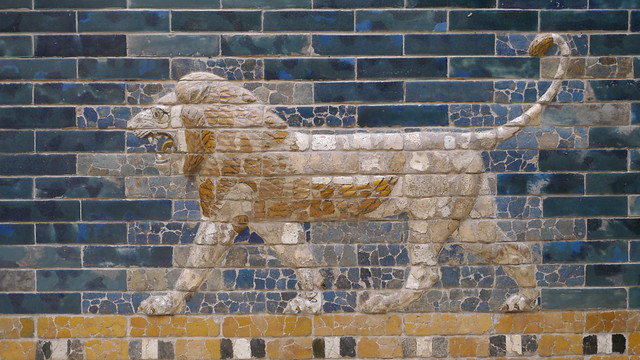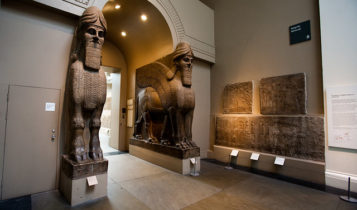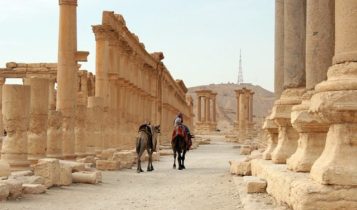The Future of Antiquity Theft and Recovery
 Lion on the Ishtar Gate, Pergamon Museum, Berlin.
https://flic.kr/p/eHpgFz
Lion on the Ishtar Gate, Pergamon Museum, Berlin.
https://flic.kr/p/eHpgFz
In March 2015, police raided four homes in northeastern Bulgaria on a contraband tip. In a decrepit shack behind one of the buildings, they found 19 stolen classical statues and several other pieces of artwork, mostly limestone or marble. Among this collection, they discovered a cuneiform tablet from the ancient Sumerian city of Lagash, near the Euphrates River in the Dhi Qar Province of modern-day Iraq. How did a tablet from an archaeological site 2995km away in Iraq get to a Bulgarian town of no particular importance? ISIL sold it to middlemen there who act as brokers for art dealers in western Europe.

Photo Patrick Lauke
Art theft and the looting of burials and other ancient sites is not new. The Taliban have been destroying Buddhist relics and sites in Afghanistan for decades, most notably the Buddhas of Bamiyan. However, insurgent groups like ISIL, particularly those active in places with easy access to archaeological sites, have instituted looting on a scale not seen since the Germans occupied Paris in 1940. According to The New York Times and The Independent, ISIL has actually begun to rely on the sale of stolen antiquities for a not insignificant amount of its funding. They can do this because newly-discovered artifacts are neither tagged nor listed in academic or museum collections and because dig sites in war zones are at best lightly secured. For example, it would be extremely difficult to sell the Mona Lisa because everyone knows what it is and that if you are selling it, it must have been stolen. It is quite easy to deal in stolen art when this is not the case, when there is a complete lack of documentation regarding the pieces in question. Additionally, there is a shortage of both academic and law enforcement expertise in the historical and archaeological areas of these artifacts. The number of people fluent in dead languages like Sumerian or Akkadian is insufficient to handle the archaeological evidence that has already been discovered, let alone enough to help police stem the tide of looted artifacts leaving Iraq and Syria. As a result, tens of thousands of items have been sold to middlemen like those in Bulgaria, who in turn sell them to New York- and London- based antiquities dealers.

This surely sounds quite uninspiring, but there is some hope. Dr. Sarah Parcak recently won the TED Prize for her involvement in a joint National Geographic–National Science Foundation project that uses satellite imagery and geospatial data to map, quantify, and track looting across archaeological sites in Egypt. Her approach has since been used in Peru, and others hope to apply it to areas affected by ISIL. It allows for a much deeper study of the affected areas, and in the right hands, it could severely hinder looting operations. Moreover, law enforcement agencies worldwide have put together a truly stunning array of resources to combat illegal antiquities trafficking. INTERPOL maintains a database of more than 50,000 known pieces of stolen art, the U.S. Department of Homeland Security has started training dozens of customs enforcement agents in coordination with the Smithsonian Museums to identify and confiscate stolen artwork, and the FBI recently established a rapid-deployment art crime team. In 2018 alone, UK police returned several artifacts to museums in Baghdad with the help of the British Museum, and the U.S. Immigration and Customs Enforcement Agency repatriated over 3800 stolen tablets and other pieces of artwork to the Republic of Iraq. Since its creation in 2004, the FBI’s Art Crime Team has recovered more than 14,850 items valued at over $165 million.
The mass looting of entire cultures is an ineffable offense. We will never recover all of these artifacts, or even a majority of them. However, we should take some solace in the collective response to that injustice and in the success of these operations to date. Over the course of the next few years, it will become much more difficult to traffic looted artifacts. Law enforcement agencies will continue to adapt, and museums like the Met and the British Museum will assist in returning artefacts that 50 years ago they would have accepted without question. In the long run, thanks to the efforts of those like Sarah Parcak, this will be regarded as an academic setback and not a catastrophic end to the study of the ancient Middle East. Here’s to you, Dr. Parcak.
Edited by Hannah Judelson-Kelly
